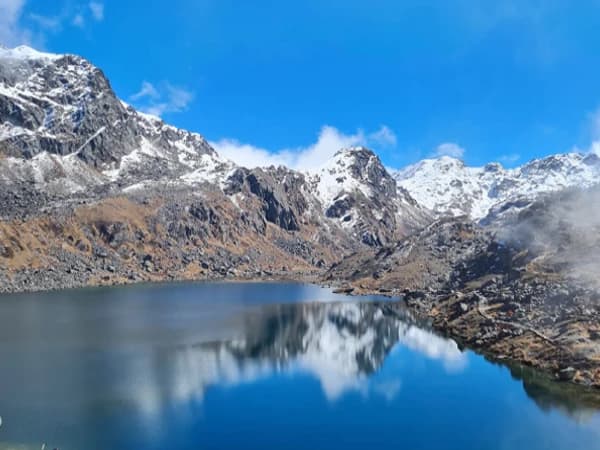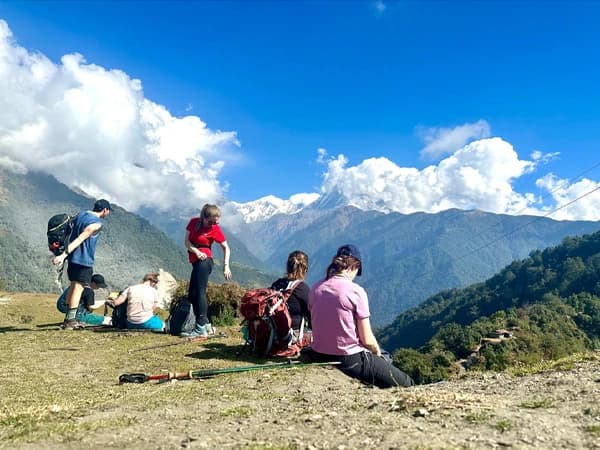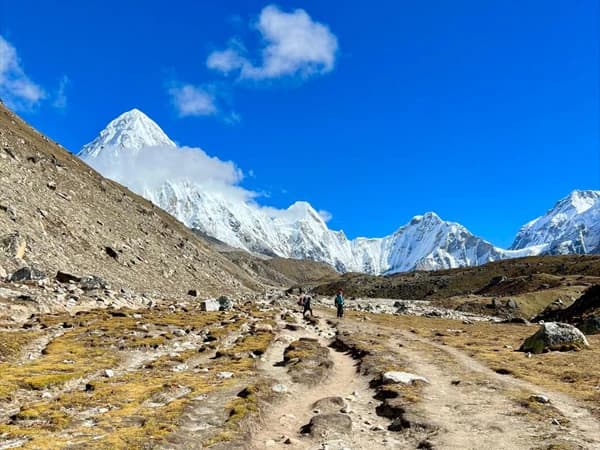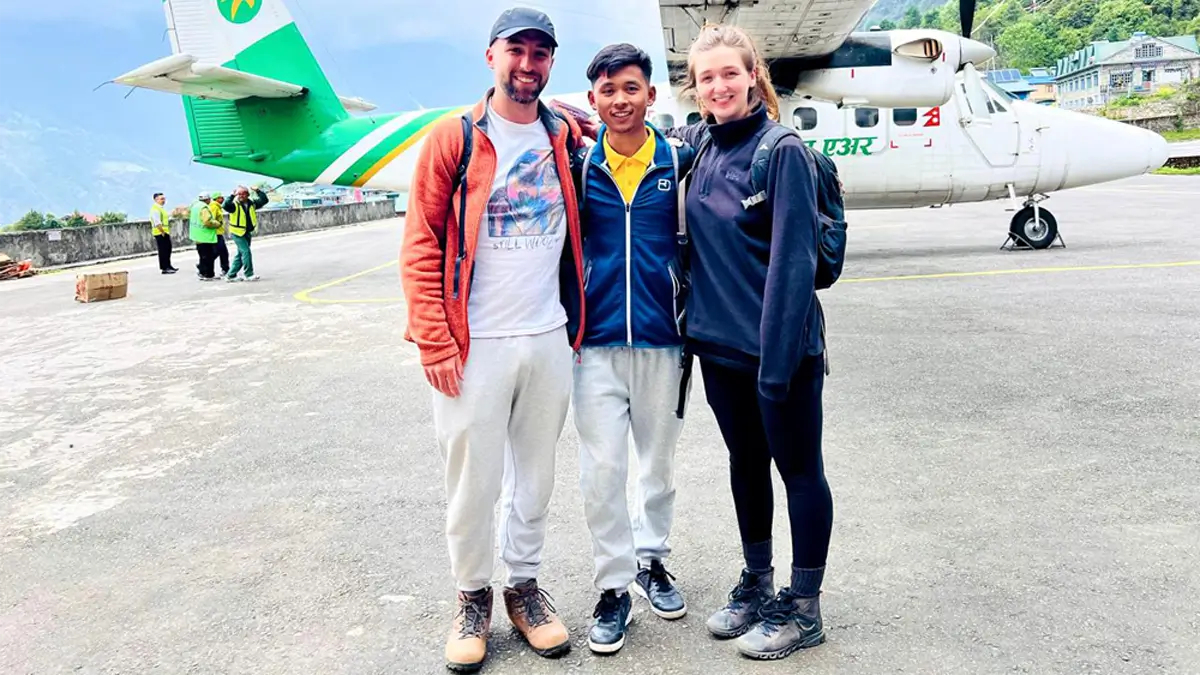
History and Background of Lukla Airport (Tenzing Hillary Airport)
Lukla Airport has one of those “only in the Himalayas” origin stories. The airport we now call the Tenzing-Hillary Airport was first built in 1964, thanks to Sir Edmund Hillary, who realized that carrying building materials for schools and hospitals on the backs of porters wasn’t exactly sustainable.
Hillary purchased the land from local Sherpa families for USD 2,650, which was a huge amount for the region at the time. But here is my favorite part: leveling the runway wasn’t done with bulldozers or fancy machines. Instead, Hillary asked the Sherpas to dance on the soil to compact it.
And this particular deal was sealed with local liquor. Imagine the birth of a world-famous airport beginning with a community dance party. It is iconic, right?
The airport opened back in 1971, and for decades, it was nothing more than a dirt strip. They didn’t pave it with asphalt until 2001. In 2008, people started calling it Tenzing-Hillary Airport to honor Hillary and Tenzing Norgay.
That airport? It turned everything around. What used to be a week-long trek to Lukla from Jiri is now just a quick flight. So yeah, Lukla Airport is a lifeline for the Everest region, a proud piece of Nepal’s Himalayan aviation story, and honestly, a bit of a legend in its own right.
Why Flying to Lukla Airport is one of the World’s Most Thrilling Flights?
Flying to Lukla Airport is honestly one of the most thrilling parts of the entire Everest adventure. And yes, this airport has earned that “world’s most dangerous airport” nickname, but not in the horror-movie way people imagine.
The runway is famously short (527 meters!) and slopes uphill at about 12%, which is basically the airport’s natural braking system. One end has a rock wall, the other has a dramatic drop into the valley, and because of the high altitude and thin air, the pilots have less lift to work with.
On top of it, with occasional wind shear, sudden gusts, and the fact that Lukla runs entirely on Visual Flight Rules (no ILS, no go-around once you commit), thus, you can see why the reputation started.
But here’s the part many people skip: the flights are operated by incredibly skilledNepali and internationalpilots who specialize in Himalayan conditions. The safety protocols are strict, the aircraft are modern, and thousands of trekkers fly to Lukla every season without issues.
For most Everest adventurers, this particular flight journey is a highlight. The view of the Himalayas from that tiny plane? Unreal. The landing? A heart-thumping “I can’t believe I just did that” moment you will brag about for years.
The Experience of Landing At Lukla Airport
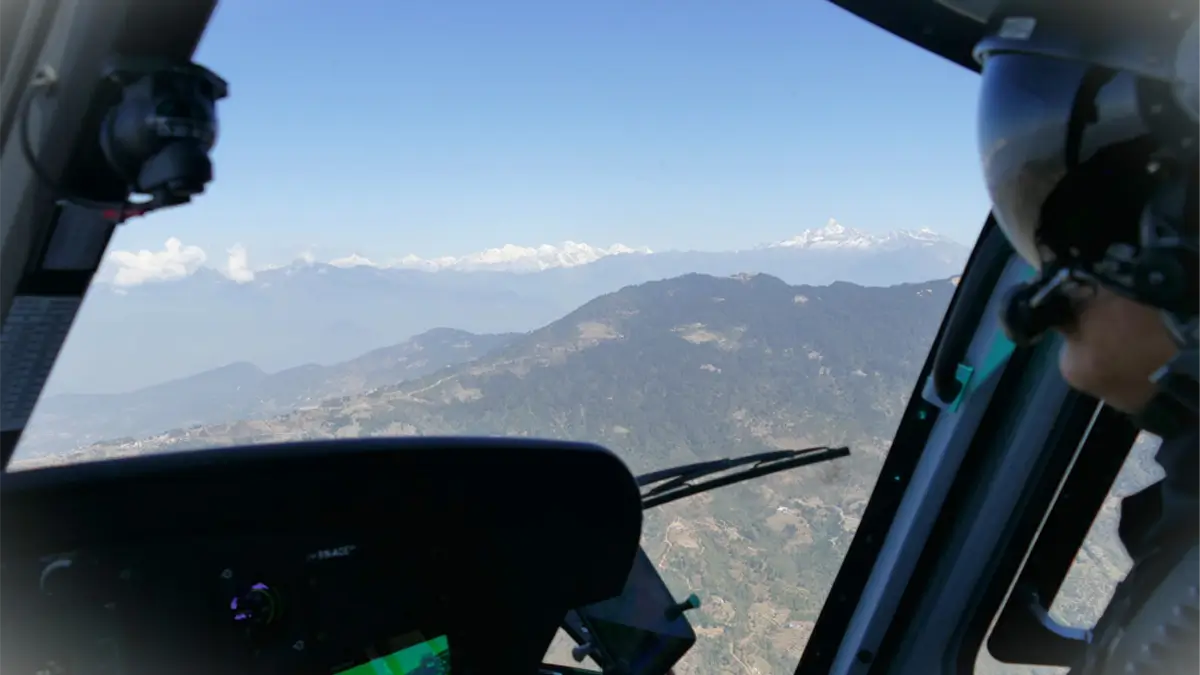
Landing at Lukla Airport sticks with you. Every Everest trekker has their own story about it. The flight kicks off with wild views—jagged snow peaks, deep valleys, the Himalayas spread out below you. It is unreal.
But when the plane starts to make its approach, things shift. Lukla doesn’t have an instrument landing system, so pilots fly almost by instinct, watching the terrain and reading the weather right in front of them. If clouds or fog roll in, you can sense the tension in the cabin.
The plane snakes between massive ridges, sometimes bumps through sudden gusts, and with the thin air up there, everything feels a little lighter, a little more unpredictable. It’s almost like you are floating.
Many passengers admit their hearts start punching the inside of their chests at this point, especially as the plane makes that signature banked turn. And then comes the landing. It is firm, precise, and sometimes a little abrupt (totally normal).
People clap when you land, almost every time. Honestly, if you don’t, you will feel out of place. Then you step off the plane and into the tiny terminal. Once you land, you get a blast of mountain air, and before you know it, you are walking toward a tea house, ready for the next part of the adventure.
So, if you feel a bit nervous before landing, trust me, that’s part of the experience.
Is flying to Lukla Airport safe?
Flying into Lukla Airport gets hyped as risky, but honestly, it’s a pretty safe bet. People love to slap it on those “most dangerous airport” lists, but the Civil Aviation Authority of Nepal keeps things tight. Only the most seasoned, STOL-certified pilots are allowed to land here, and flights only go when the weather is clear. They even weigh your bags down to the last kilo.
Most planes leave early, when the sky is clear and the wind isn’t causing trouble. The crews have this down to a science. These planes are built for short, tough runways, and honestly, the Lukla strip gets inspected more than a lot of city roads.
Delays or cancellations? Sure, you get those, as it is just part of the whole adventure. But accidents? They barely ever happen, even with all the trekkers flying in every day.
So, here is the truth: Lukla Airport is safe. Thousands of people do this trip every year without a hitch. The thrill is real, but so is the safety.
Safety Standards for Lukla Flights
- Only pilots with serious STOL (short takeoff and landing) experience get to fly into Lukla. They need at least 100 STOL missions in Nepal and have to nail 10 Lukla landings under supervision before they are cleared.
- Flights at Lukla don’t budge unless the sky is clear. If it is a foggy morning, everyone just hangs around and waits. When the weather goes south, flights get pushed back or scrapped.
- You can only bring 15 kilos of baggage. Pack smart, as if you try to sneak in more, you will end up leaving something behind.
- Not every plane can tackle Lukla’s runway. Only certain ones make the cut, like the Twin Otter, Dornier 228, or Let L-410. The runway itself gets regular checkups for cracks, weird slopes, anything that could mess with a landing.
- Most flights take off early, right after sunrise, because that’s when the weather usually plays nice.
- The pilots, crew, and ground staff know exactly what they are doing. They are trained for anything, from emergencies to fire to rescues.
- If the tailwinds pick up past safe levels, flights stop. No exceptions.
Kathmandu to Lukla Airport Flight Details
If you are trekking to Everest, the Kathmandu to Lukla flight gets you straight into the heart of the Himalayas. The aerial distance is only about 138 km, and depending on the weather, the flight takes 40 to 50 minutes.
Most flights leave from the Kathmandu domestic terminal early in the morning, usually between 6 AM and noon, SOmetimes f good weather till 2 or 3 pm, because the mountain weather behaves best in the morning. After that, clouds, winds, and Himalayan moods start acting up. This is also why you must build 1 to 2 buffer days into your Everest itinerary.
On a clear day, you will see snow-capped giants, deep valleys, terraced hillsides, and maybe even Everest, Lhotse, Ama Dablam, and more. Pro tip: choose a left-side window seat for the best Himalayan views.
During peak trekking seasons, spring (March to May) and autumn (September to November), these flights get booked out fast. Therefore, you must plan ahead.
Flying to Lukla from Ramechhap (Manthali Airport)
When trekking season hits, there is just one flight to Lukla leaving from Kathmandu and switching over to Ramechhap, out at Manthali Airport.
Kathmandu turns into a madhouse, so moving flights to Ramechhap just makes life easier. The airport chaos cools down, flights actually leave on time, and the whole thing feels way less stressful.
Ramechhap Airport sits about 132 kilometers east of Kathmandu. It is honestly a tiny place, and during the busy months, it is all about those Lukla flights.
One catch, though: you have got to leave Kathmandu at something like 1:30 in the morning if you want to make it. Yeah, it’s brutal, but trust me, it pays off. When you finally get there, things move quickly.
The drive is about four and a half hours. It depends on traffic and how rough the roads are. You wind through hills, hit some sketchy bumps, and deal with that ice-cold air before sunrise. But after all that, you finally get on the tiny plane. 12-15 minutes later, you are in Lukla.
Cost of Flying to Lukla Airport: Booking Tips & Seasonal Changes
Flying to Lukla is pretty much your ticket into the Everest region, and honestly, it will take a good bite out of your trekking budget. The price jumps around a lot; it depends on when you are going, whether you are flying out of Kathmandu or Ramechhap, and how far ahead you book.
Most foreign trekkers pay somewhere about 224 USD one way, and about 448 USD for a round trip. When trekking season is at its peak, prices shoot up, seats disappear in a flash, and waiting till the last minute is just asking for disappointment.
If you are heading out during busy months, you really need to book early. Off-season flights, think monsoon or winter, can cost a little less, but there is a catch. The weather gets wild and unpredictable, so delays and cancellations are way more common.
Booking Tips / Strategies to Save or Secure Better Prices
- Book your tickets as early as you can, especially if you are traveling during the busy season. Seats go fast, and waiting around isn’t a good idea.
- Local trekking companies can be a lifesaver, they sometimes snag special deals or hold seats you won’t see online.
- Give yourself a couple of extra days, just in case your flight gets delayed or canceled.
- Check flights from both Kathmandu and Ramechhap. During peak months, you will usually find more choices from Ramechhap.
- And if you end up stuck or everything is full, consider splitting the cost of a helicopter. It’s pricier, but sometimes it’s the only way to keep your trip moving.
Alternative Ways to Reach the Everest Region Without Flying to Lukla
Helicopter Flights to Lukla Airport: Prices, Safety, & When to Choose One
Flying to Lukla by helicopter just makes things easier. You get more flexibility, smoother travel, and, it is a classic Himalayan adventure.
If you are tired of rolling the dice with fixed-wing flights, switching to a heli is a solid way to cut through the hassle and jump straight into the Everest region. Plus, you skip the long waits and get a front-row view of the mountains.
Helicopters can handle weather and tricky landings way better than planes. They fly when planes get grounded, and they can touch down in places a regular aircraft just can’t reach. Fewer cancellations. Less waiting around. And the scenery? It is wild, mountains everywhere, right out your window.
Let’s get real about the costs. If you join a group flight, you are looking at about USD 550 to 600 per person to get from Kathmandu to Lukla. If you want the whole helicopter, that will set you back USD 2,500 to 3,000, sometimes even more.
But here is the thing: you can squeeze in around five people, so splitting the bill makes it a lot less painful. Prices shoot up during the busy trekking season, when everyone decides they want to be Everest adventurers.
Helicopters are a total game-changer if your Lukla flight gets canceled and you really don’t feel like living at the airport café for two days. They are also perfect if you want to skip the lower villages and dive straight into the mountains, or if you are short on time and flying out sounds way better than hiking all the way down.
Overland Route via Salleri / Phaplu
The overland route via Salleri, Phaplu or Thapla Danda is also your chill, grounded alternative. Forget the quick, dramatic flight this time; you are in for a classic Nepali road trip. Picture winding hill roads, little villages sliding by outside your window. It is bumpy, sometimes slow, but there is a charm to it.
Getting from Kathmandu to Salleri, Phaplu, or Thapla Danda isn’t quick. It is an 15-16 hours ride in a jeep or bus, and the road keeps things interesting with traffic, bumps, the whole deal.
Starting from Salleri, you will spend three or four days on foot before you meet up with the main Everest Base Camp trail near Surke and Phakding. It’s not the fastest way in, but that’s the point.
You actually get time to take it all in: more chances to chat with locals, more space to breathe, and way fewer crowds before you hit the busy Khumbu area. If you want a trip with more culture and a little peace and quiet, this is the way to go.
Classic Jiri Route (Overland Trek)
If you want to see the Everest region the way early climbers did, before Lukla Airport made things easy, the Classic Jiri Route is the way to go. You start with a drive from Kathmandu to Jiri, Thapla Danda then hit the trail.
Over the next four or five days, you will walk through quiet villages, thick forests, rickety suspension bridges, and endless terraced fields. You won’t see many other trekkers, and honestly, the whole thing feels like a step back in time to the trekking days of the 1970s. Eventually, you will link up with the main Everest Base Camp trail just outside Lukla.
There’s a catch, though, paperwork. You need three permits: Gaurishankar Conservation Area, Khumbu Entrance, and Sagarmatha National Park. Not too bad, but worth knowing before you go.
Is Flying to Lukla Airport Worth it for your Everest Adventure?
No question: flying into Lukla is worth every minute. One moment you are in Kathmandu, and half an hour later, you are standing at the doorstep of the Himalayas. The Tenzing-Hillary Airport, small but tough, saves you days of trekking and drops you right where the Everest adventure begins.
But it’s more than just a shortcut. That flight keeps the Sherpa community connected to the world. Supplies, food, building materials, even emergency rescues, everything comes through that runway. For the people living up there, Lukla Airport is a lifeline.
FAQs
How high is Lukla Airport?
Lukla Airport sits at 2,860 meters, or about 9,383 feet, above sea level.
How long is the runway at Lukla Airport?
The runway is pretty short, just 527 meters, or 1,729 feet. It’s built for planes that can take off and land in tight spaces.
Which airlines fly to Lukla Airport?
You will find flights from Summit Air, Tara Air, Sita Air, and Yeti Airlines. They usually fly from Kathmandu or Ramechhap.
How safe is Lukla Airport?
The airport is known for tough terrain, but pilots here are highly skilled. They follow strict weather rules and updated safety procedures, so it’s considered safe.
Is Lukla Airport the highest in the world?
No, it’s not the highest, but it’s definitely up there among the highest commercial airports. And honestly, it’s the gateway if you are heading into the Everest region.




